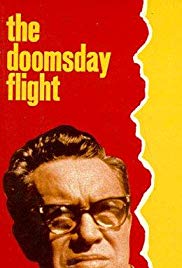Plot
At Los Angeles International Airport, a Douglas DC-8 airliner takes off for New York. Shortly after takeoff, the airline receives a bomb threat. The stranger on the telephone asks for a sum of $100,000 in small denominations. He also states that the bomb is hidden in the cabin. The stranger is actually a former engineer who worked in the aviation industry.
The company Chief Pilot Bob Shea decides to warn the flight crew. He orders pilot Capt. Anderson, to circle around Las Vegas. He also asks the flight crew to search for the bomb on board. It is revealed that the bomb has an aneroid, altitude-sensitive switch and will detonate if the aircraft lands.
Meanwhile, the search to find the bomb on board the flight involves the opening of passenger hand luggage and tearing open several areas in the cabin and cockpit. All efforts are unsuccessful. The passengers are alerted to the emergency and start to panic.
The bomb threat caller telephones again to tell the police how to pay the ransom. A delivery man will simply come to the airport and take the money. The police follow the van closely, but the van has a serious accident on a ring road and catches fire. The terrorist has trouble believing the police who confirm that they are preparing a second payment. He seeks refuge at a bar, where he drinks a lot and starts talking to the bartender who is suspicious of the caller.
When the caller has a heart attack, the bartender calls the police who come running, but the man is dead. The FBI Special Agent Frank Thompson then interrogates the bartender asking him to report the exact words of the terrorist. The police discover that the bomb will explode if the airliner drops below 4,000 feet.
The chief pilot then decides to tell the flight crew to land the aircraft at Stapleton International Airport in Denver, Colorado, whose altitude is higher, and landing there will not trigger the bomb. After the airliner is safely on the ground, the flight crew meet in the airline operations room of his company.
In the end, by chance, the bomb is discovered where it was least expected –in the pilot's chart case.
Release
The Doomsday Flight premiered in Canada on CTV on 10 December 1966, and on NBC in the United States on 13 December 1966. On NBC, it was the most watched made-for-TV movie to that time, with a Nielsen rating of 27.5 and an audience share of 48% until it was surpassed by Heidi in 1968.
The Doomsday Flight was released theatrically in cinemas in other countries around the world, [5] and distributed by the Rank Organisation in the UK. [6]
MCA Home Video released "The Doomsday Flight" on VHS in 1986.
This page is based on this
Wikipedia article Text is available under the
CC BY-SA 4.0 license; additional terms may apply.
Images, videos and audio are available under their respective licenses.
